Young International Students' Willingness to Work with Old People
VerifiedAdded on 2023/06/13
|17
|4231
|326
AI Summary
This research proposal aims to investigate the willingness of young international students to work with older people in the same office. It discusses the impact of age diversity in the workplace and how organizations can influence age diversity. The proposal includes a literature review on ageism, age attitudes and stereotypes in the workplace, ageing anxiety, and contact with older adults. The research questions and objectives are also outlined.
Contribute Materials
Your contribution can guide someone’s learning journey. Share your
documents today.

Research Proposal 1
Research Proposal about Young International Students Willing to Work with Old People
By [Name]
Course
Professors’ Name
Institution
Location of Institution
Date
Research Proposal about Young International Students Willing to Work with Old People
By [Name]
Course
Professors’ Name
Institution
Location of Institution
Date
Secure Best Marks with AI Grader
Need help grading? Try our AI Grader for instant feedback on your assignments.
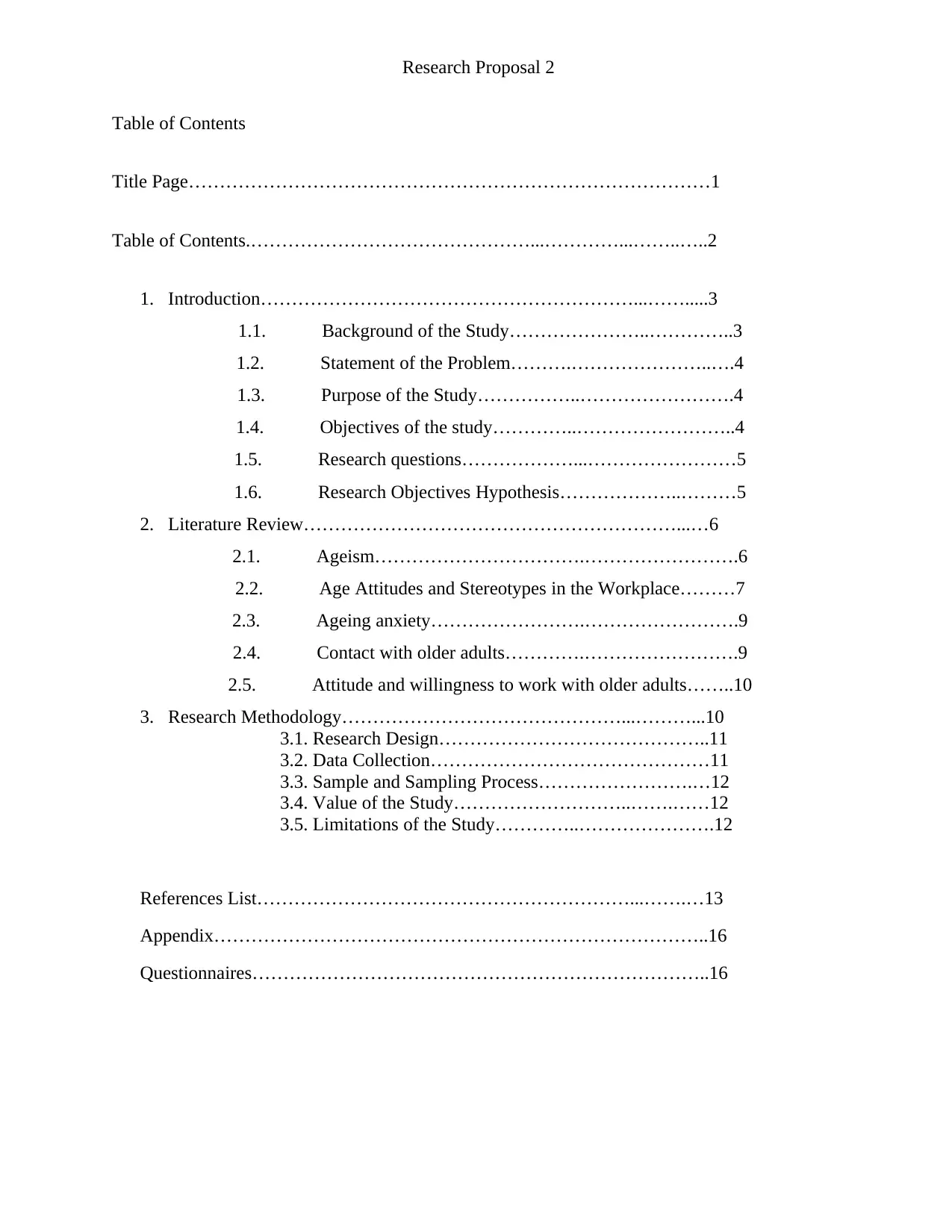
Research Proposal 2
Table of Contents
Title Page…………………………………………………………………………1
Table of Contents.………………………………………...…………...……..…..2
1. Introduction……………………………………………………...…….....3
1.1. Background of the Study…………………..…………..3
1.2. Statement of the Problem……….…………………..….4
1.3. Purpose of the Study……………..…………………….4
1.4. Objectives of the study…………..……………………..4
1.5. Research questions………………...……………………5
1.6. Research Objectives Hypothesis………………..………5
2. Literature Review……………………………………………………...…6
2.1. Ageism…………………………….…………………….6
2.2. Age Attitudes and Stereotypes in the Workplace………7
2.3. Ageing anxiety…………………….…………………….9
2.4. Contact with older adults………….…………………….9
2.5. Attitude and willingness to work with older adults……..10
3. Research Methodology………………………………………...………...10
3.1. Research Design……………………………………..11
3.2. Data Collection………………………………………11
3.3. Sample and Sampling Process…………………….…12
3.4. Value of the Study………………………..…….……12
3.5. Limitations of the Study…………..………………….12
References List……………………………………………………...…….…13
Appendix……………………………………………………………………..16
Questionnaires………………………………………………………………..16
Table of Contents
Title Page…………………………………………………………………………1
Table of Contents.………………………………………...…………...……..…..2
1. Introduction……………………………………………………...…….....3
1.1. Background of the Study…………………..…………..3
1.2. Statement of the Problem……….…………………..….4
1.3. Purpose of the Study……………..…………………….4
1.4. Objectives of the study…………..……………………..4
1.5. Research questions………………...……………………5
1.6. Research Objectives Hypothesis………………..………5
2. Literature Review……………………………………………………...…6
2.1. Ageism…………………………….…………………….6
2.2. Age Attitudes and Stereotypes in the Workplace………7
2.3. Ageing anxiety…………………….…………………….9
2.4. Contact with older adults………….…………………….9
2.5. Attitude and willingness to work with older adults……..10
3. Research Methodology………………………………………...………...10
3.1. Research Design……………………………………..11
3.2. Data Collection………………………………………11
3.3. Sample and Sampling Process…………………….…12
3.4. Value of the Study………………………..…….……12
3.5. Limitations of the Study…………..………………….12
References List……………………………………………………...…….…13
Appendix……………………………………………………………………..16
Questionnaires………………………………………………………………..16
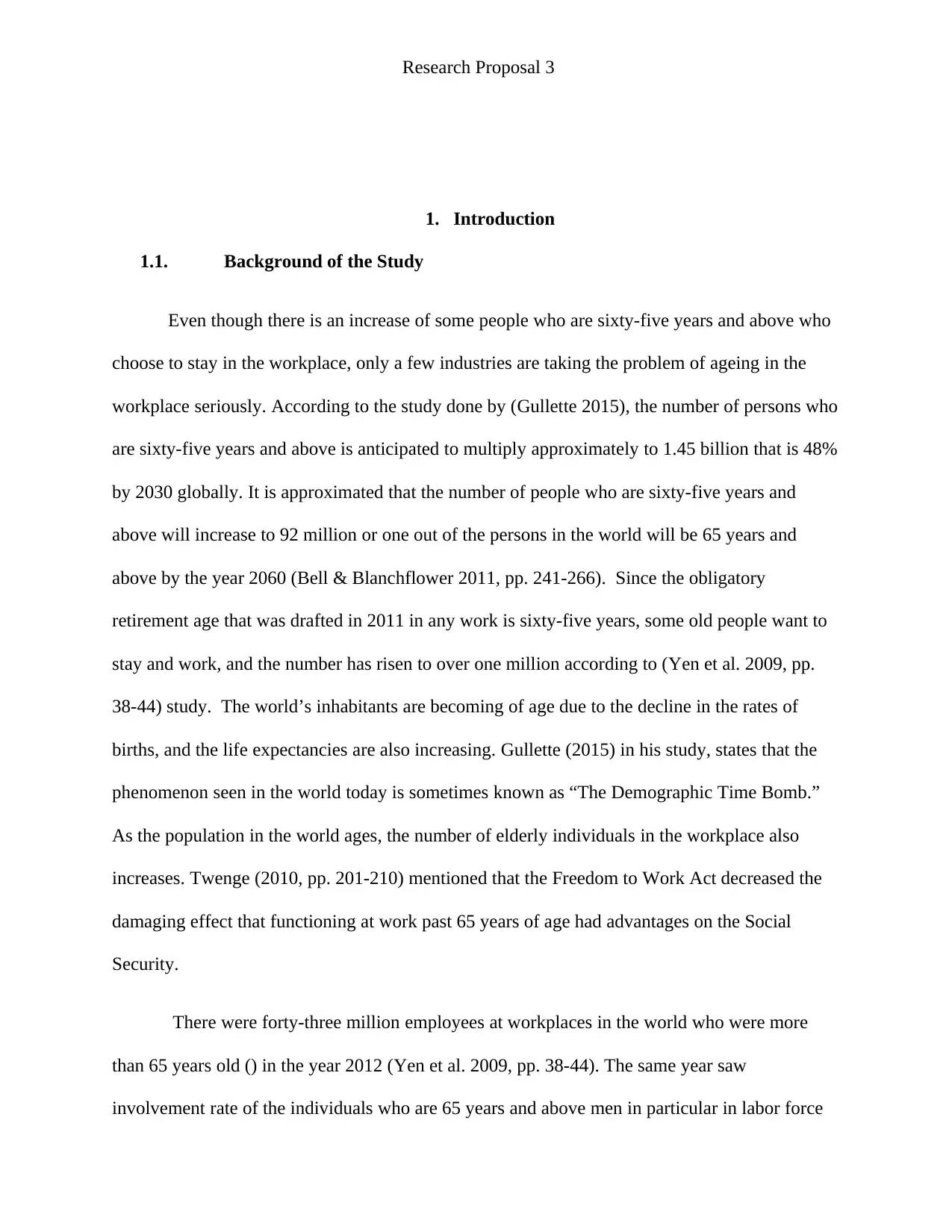
Research Proposal 3
1. Introduction
1.1. Background of the Study
Even though there is an increase of some people who are sixty-five years and above who
choose to stay in the workplace, only a few industries are taking the problem of ageing in the
workplace seriously. According to the study done by (Gullette 2015), the number of persons who
are sixty-five years and above is anticipated to multiply approximately to 1.45 billion that is 48%
by 2030 globally. It is approximated that the number of people who are sixty-five years and
above will increase to 92 million or one out of the persons in the world will be 65 years and
above by the year 2060 (Bell & Blanchflower 2011, pp. 241-266). Since the obligatory
retirement age that was drafted in 2011 in any work is sixty-five years, some old people want to
stay and work, and the number has risen to over one million according to (Yen et al. 2009, pp.
38-44) study. The world’s inhabitants are becoming of age due to the decline in the rates of
births, and the life expectancies are also increasing. Gullette (2015) in his study, states that the
phenomenon seen in the world today is sometimes known as “The Demographic Time Bomb.”
As the population in the world ages, the number of elderly individuals in the workplace also
increases. Twenge (2010, pp. 201-210) mentioned that the Freedom to Work Act decreased the
damaging effect that functioning at work past 65 years of age had advantages on the Social
Security.
There were forty-three million employees at workplaces in the world who were more
than 65 years old () in the year 2012 (Yen et al. 2009, pp. 38-44). The same year saw
involvement rate of the individuals who are 65 years and above men in particular in labor force
1. Introduction
1.1. Background of the Study
Even though there is an increase of some people who are sixty-five years and above who
choose to stay in the workplace, only a few industries are taking the problem of ageing in the
workplace seriously. According to the study done by (Gullette 2015), the number of persons who
are sixty-five years and above is anticipated to multiply approximately to 1.45 billion that is 48%
by 2030 globally. It is approximated that the number of people who are sixty-five years and
above will increase to 92 million or one out of the persons in the world will be 65 years and
above by the year 2060 (Bell & Blanchflower 2011, pp. 241-266). Since the obligatory
retirement age that was drafted in 2011 in any work is sixty-five years, some old people want to
stay and work, and the number has risen to over one million according to (Yen et al. 2009, pp.
38-44) study. The world’s inhabitants are becoming of age due to the decline in the rates of
births, and the life expectancies are also increasing. Gullette (2015) in his study, states that the
phenomenon seen in the world today is sometimes known as “The Demographic Time Bomb.”
As the population in the world ages, the number of elderly individuals in the workplace also
increases. Twenge (2010, pp. 201-210) mentioned that the Freedom to Work Act decreased the
damaging effect that functioning at work past 65 years of age had advantages on the Social
Security.
There were forty-three million employees at workplaces in the world who were more
than 65 years old () in the year 2012 (Yen et al. 2009, pp. 38-44). The same year saw
involvement rate of the individuals who are 65 years and above men in particular in labor force
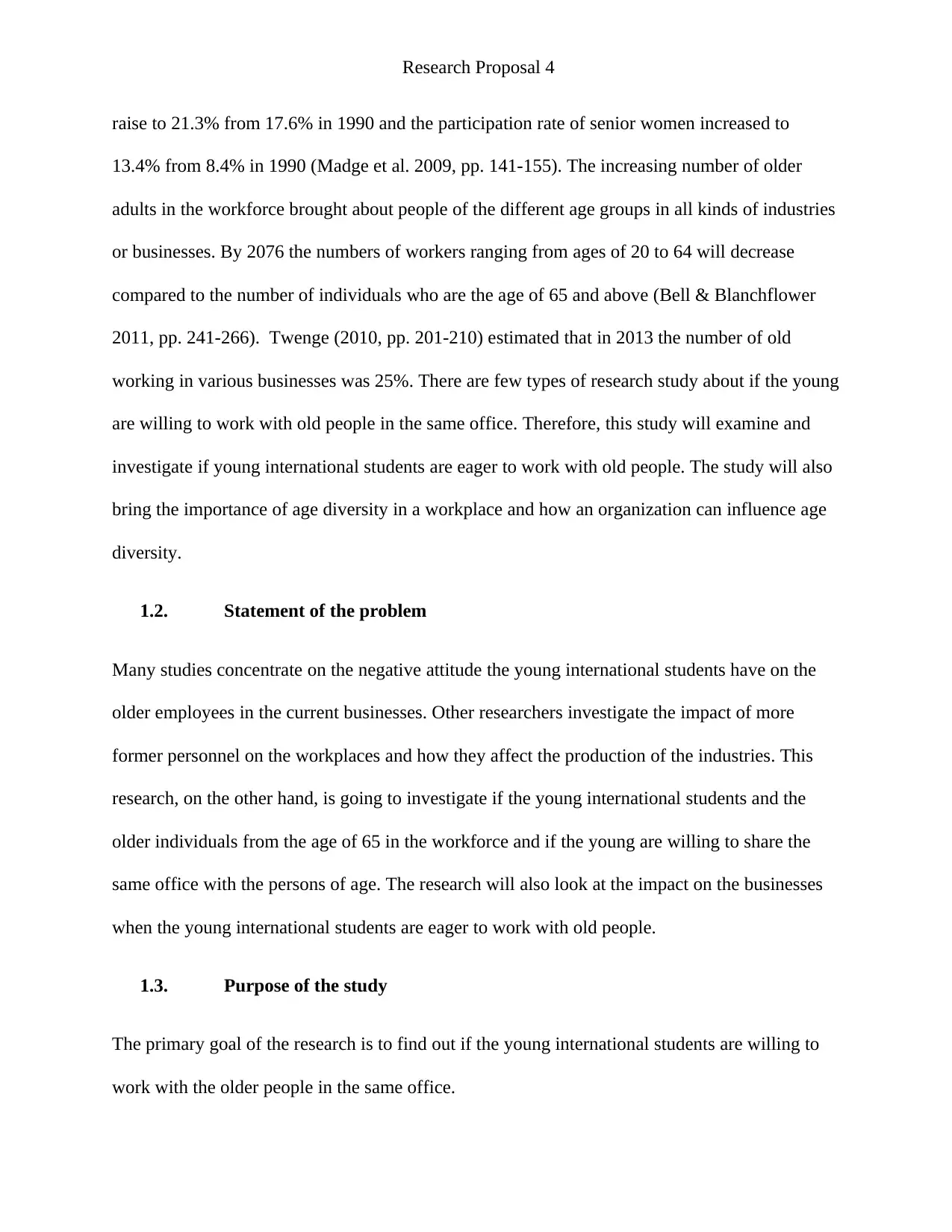
Research Proposal 4
raise to 21.3% from 17.6% in 1990 and the participation rate of senior women increased to
13.4% from 8.4% in 1990 (Madge et al. 2009, pp. 141-155). The increasing number of older
adults in the workforce brought about people of the different age groups in all kinds of industries
or businesses. By 2076 the numbers of workers ranging from ages of 20 to 64 will decrease
compared to the number of individuals who are the age of 65 and above (Bell & Blanchflower
2011, pp. 241-266). Twenge (2010, pp. 201-210) estimated that in 2013 the number of old
working in various businesses was 25%. There are few types of research study about if the young
are willing to work with old people in the same office. Therefore, this study will examine and
investigate if young international students are eager to work with old people. The study will also
bring the importance of age diversity in a workplace and how an organization can influence age
diversity.
1.2. Statement of the problem
Many studies concentrate on the negative attitude the young international students have on the
older employees in the current businesses. Other researchers investigate the impact of more
former personnel on the workplaces and how they affect the production of the industries. This
research, on the other hand, is going to investigate if the young international students and the
older individuals from the age of 65 in the workforce and if the young are willing to share the
same office with the persons of age. The research will also look at the impact on the businesses
when the young international students are eager to work with old people.
1.3. Purpose of the study
The primary goal of the research is to find out if the young international students are willing to
work with the older people in the same office.
raise to 21.3% from 17.6% in 1990 and the participation rate of senior women increased to
13.4% from 8.4% in 1990 (Madge et al. 2009, pp. 141-155). The increasing number of older
adults in the workforce brought about people of the different age groups in all kinds of industries
or businesses. By 2076 the numbers of workers ranging from ages of 20 to 64 will decrease
compared to the number of individuals who are the age of 65 and above (Bell & Blanchflower
2011, pp. 241-266). Twenge (2010, pp. 201-210) estimated that in 2013 the number of old
working in various businesses was 25%. There are few types of research study about if the young
are willing to work with old people in the same office. Therefore, this study will examine and
investigate if young international students are eager to work with old people. The study will also
bring the importance of age diversity in a workplace and how an organization can influence age
diversity.
1.2. Statement of the problem
Many studies concentrate on the negative attitude the young international students have on the
older employees in the current businesses. Other researchers investigate the impact of more
former personnel on the workplaces and how they affect the production of the industries. This
research, on the other hand, is going to investigate if the young international students and the
older individuals from the age of 65 in the workforce and if the young are willing to share the
same office with the persons of age. The research will also look at the impact on the businesses
when the young international students are eager to work with old people.
1.3. Purpose of the study
The primary goal of the research is to find out if the young international students are willing to
work with the older people in the same office.
Secure Best Marks with AI Grader
Need help grading? Try our AI Grader for instant feedback on your assignments.
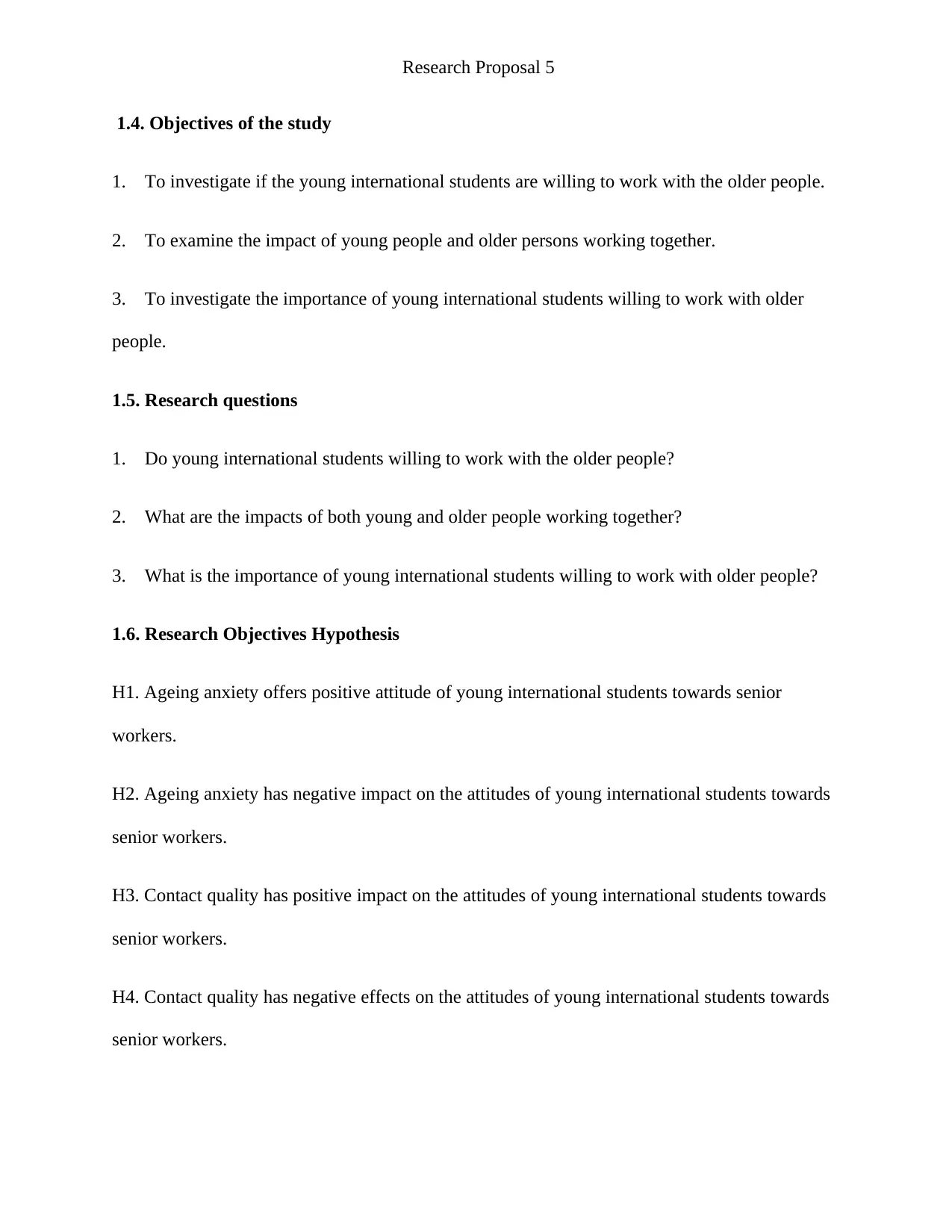
Research Proposal 5
1.4. Objectives of the study
1. To investigate if the young international students are willing to work with the older people.
2. To examine the impact of young people and older persons working together.
3. To investigate the importance of young international students willing to work with older
people.
1.5. Research questions
1. Do young international students willing to work with the older people?
2. What are the impacts of both young and older people working together?
3. What is the importance of young international students willing to work with older people?
1.6. Research Objectives Hypothesis
H1. Ageing anxiety offers positive attitude of young international students towards senior
workers.
H2. Ageing anxiety has negative impact on the attitudes of young international students towards
senior workers.
H3. Contact quality has positive impact on the attitudes of young international students towards
senior workers.
H4. Contact quality has negative effects on the attitudes of young international students towards
senior workers.
1.4. Objectives of the study
1. To investigate if the young international students are willing to work with the older people.
2. To examine the impact of young people and older persons working together.
3. To investigate the importance of young international students willing to work with older
people.
1.5. Research questions
1. Do young international students willing to work with the older people?
2. What are the impacts of both young and older people working together?
3. What is the importance of young international students willing to work with older people?
1.6. Research Objectives Hypothesis
H1. Ageing anxiety offers positive attitude of young international students towards senior
workers.
H2. Ageing anxiety has negative impact on the attitudes of young international students towards
senior workers.
H3. Contact quality has positive impact on the attitudes of young international students towards
senior workers.
H4. Contact quality has negative effects on the attitudes of young international students towards
senior workers.
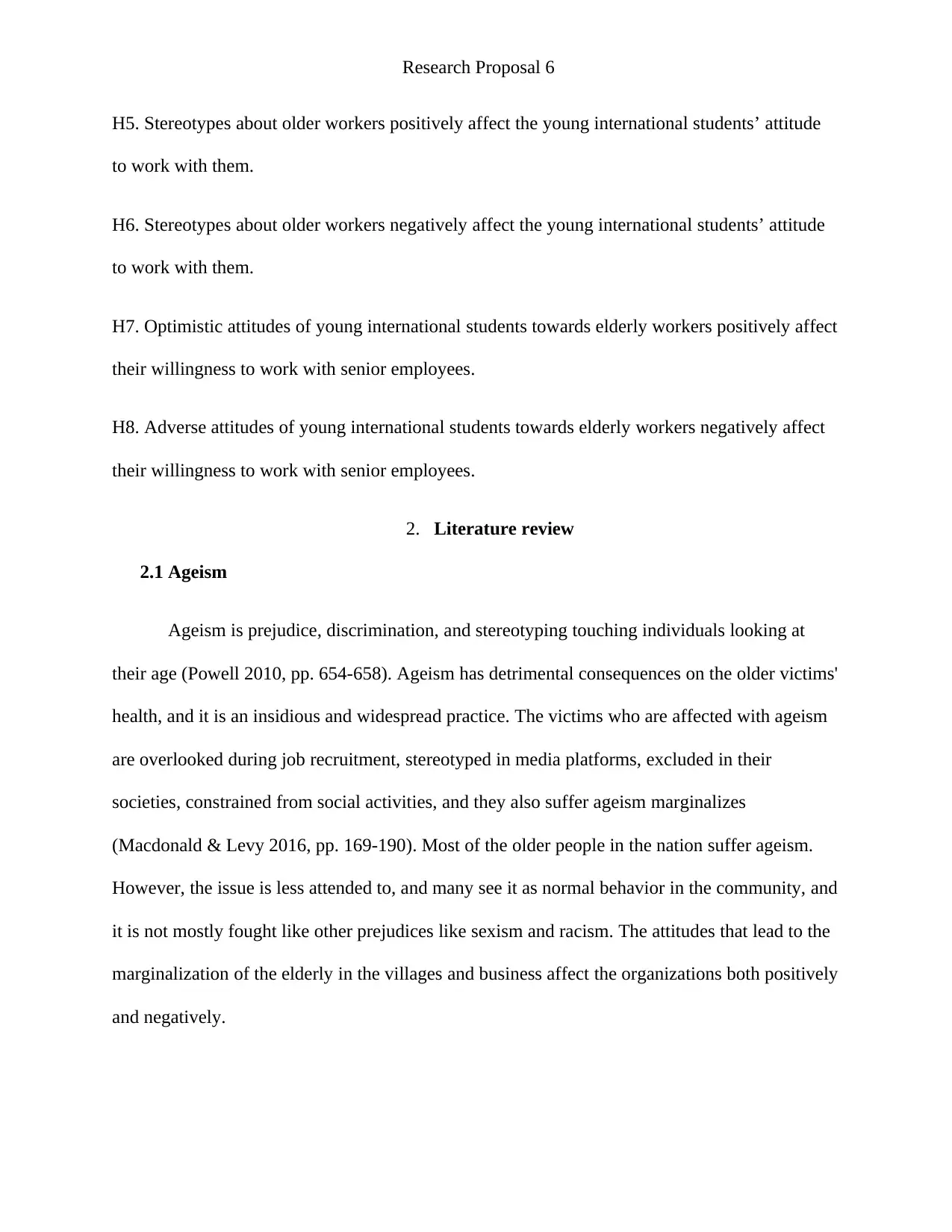
Research Proposal 6
H5. Stereotypes about older workers positively affect the young international students’ attitude
to work with them.
H6. Stereotypes about older workers negatively affect the young international students’ attitude
to work with them.
H7. Optimistic attitudes of young international students towards elderly workers positively affect
their willingness to work with senior employees.
H8. Adverse attitudes of young international students towards elderly workers negatively affect
their willingness to work with senior employees.
2. Literature review
2.1 Ageism
Ageism is prejudice, discrimination, and stereotyping touching individuals looking at
their age (Powell 2010, pp. 654-658). Ageism has detrimental consequences on the older victims'
health, and it is an insidious and widespread practice. The victims who are affected with ageism
are overlooked during job recruitment, stereotyped in media platforms, excluded in their
societies, constrained from social activities, and they also suffer ageism marginalizes
(Macdonald & Levy 2016, pp. 169-190). Most of the older people in the nation suffer ageism.
However, the issue is less attended to, and many see it as normal behavior in the community, and
it is not mostly fought like other prejudices like sexism and racism. The attitudes that lead to the
marginalization of the elderly in the villages and business affect the organizations both positively
and negatively.
H5. Stereotypes about older workers positively affect the young international students’ attitude
to work with them.
H6. Stereotypes about older workers negatively affect the young international students’ attitude
to work with them.
H7. Optimistic attitudes of young international students towards elderly workers positively affect
their willingness to work with senior employees.
H8. Adverse attitudes of young international students towards elderly workers negatively affect
their willingness to work with senior employees.
2. Literature review
2.1 Ageism
Ageism is prejudice, discrimination, and stereotyping touching individuals looking at
their age (Powell 2010, pp. 654-658). Ageism has detrimental consequences on the older victims'
health, and it is an insidious and widespread practice. The victims who are affected with ageism
are overlooked during job recruitment, stereotyped in media platforms, excluded in their
societies, constrained from social activities, and they also suffer ageism marginalizes
(Macdonald & Levy 2016, pp. 169-190). Most of the older people in the nation suffer ageism.
However, the issue is less attended to, and many see it as normal behavior in the community, and
it is not mostly fought like other prejudices like sexism and racism. The attitudes that lead to the
marginalization of the elderly in the villages and business affect the organizations both positively
and negatively.
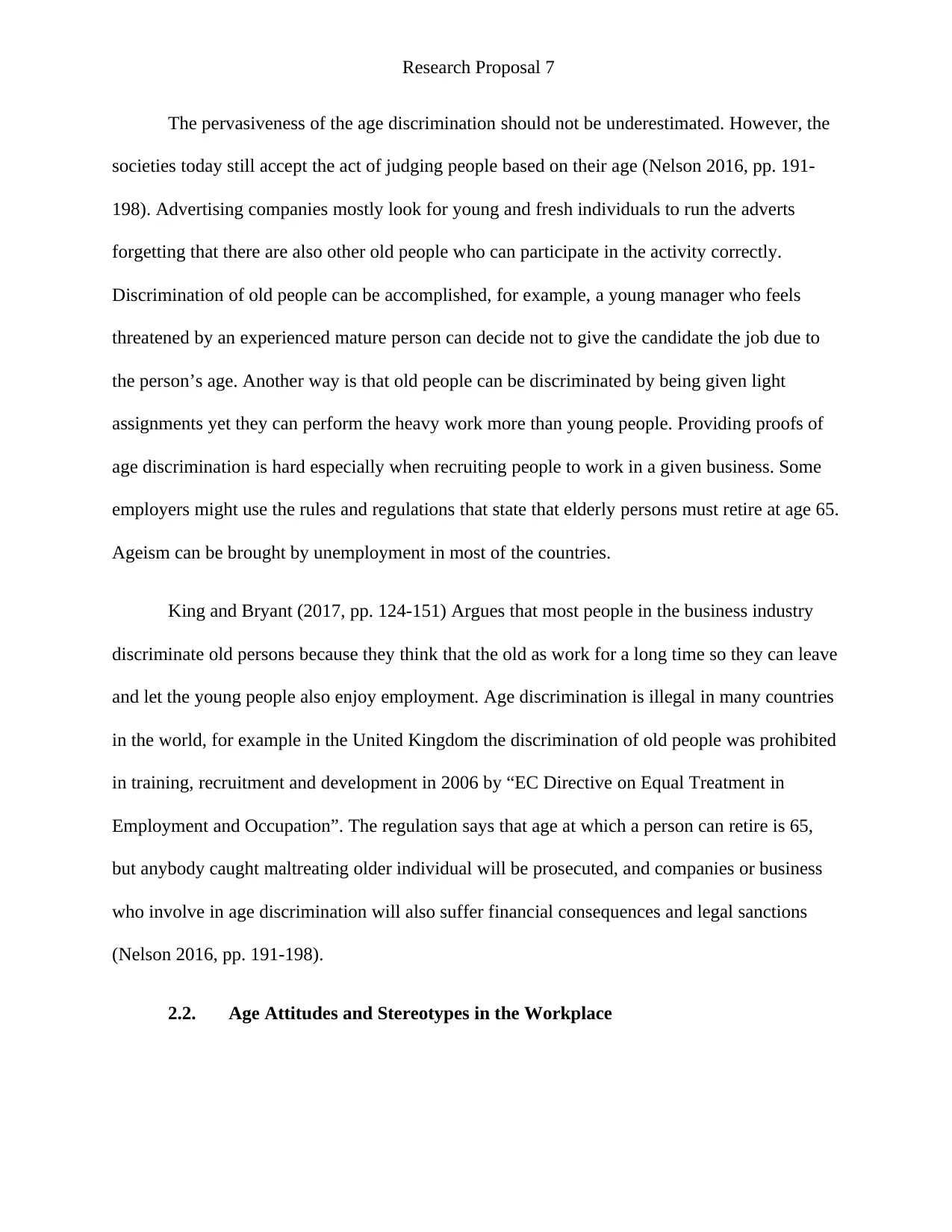
Research Proposal 7
The pervasiveness of the age discrimination should not be underestimated. However, the
societies today still accept the act of judging people based on their age (Nelson 2016, pp. 191-
198). Advertising companies mostly look for young and fresh individuals to run the adverts
forgetting that there are also other old people who can participate in the activity correctly.
Discrimination of old people can be accomplished, for example, a young manager who feels
threatened by an experienced mature person can decide not to give the candidate the job due to
the person’s age. Another way is that old people can be discriminated by being given light
assignments yet they can perform the heavy work more than young people. Providing proofs of
age discrimination is hard especially when recruiting people to work in a given business. Some
employers might use the rules and regulations that state that elderly persons must retire at age 65.
Ageism can be brought by unemployment in most of the countries.
King and Bryant (2017, pp. 124-151) Argues that most people in the business industry
discriminate old persons because they think that the old as work for a long time so they can leave
and let the young people also enjoy employment. Age discrimination is illegal in many countries
in the world, for example in the United Kingdom the discrimination of old people was prohibited
in training, recruitment and development in 2006 by “EC Directive on Equal Treatment in
Employment and Occupation”. The regulation says that age at which a person can retire is 65,
but anybody caught maltreating older individual will be prosecuted, and companies or business
who involve in age discrimination will also suffer financial consequences and legal sanctions
(Nelson 2016, pp. 191-198).
2.2. Age Attitudes and Stereotypes in the Workplace
The pervasiveness of the age discrimination should not be underestimated. However, the
societies today still accept the act of judging people based on their age (Nelson 2016, pp. 191-
198). Advertising companies mostly look for young and fresh individuals to run the adverts
forgetting that there are also other old people who can participate in the activity correctly.
Discrimination of old people can be accomplished, for example, a young manager who feels
threatened by an experienced mature person can decide not to give the candidate the job due to
the person’s age. Another way is that old people can be discriminated by being given light
assignments yet they can perform the heavy work more than young people. Providing proofs of
age discrimination is hard especially when recruiting people to work in a given business. Some
employers might use the rules and regulations that state that elderly persons must retire at age 65.
Ageism can be brought by unemployment in most of the countries.
King and Bryant (2017, pp. 124-151) Argues that most people in the business industry
discriminate old persons because they think that the old as work for a long time so they can leave
and let the young people also enjoy employment. Age discrimination is illegal in many countries
in the world, for example in the United Kingdom the discrimination of old people was prohibited
in training, recruitment and development in 2006 by “EC Directive on Equal Treatment in
Employment and Occupation”. The regulation says that age at which a person can retire is 65,
but anybody caught maltreating older individual will be prosecuted, and companies or business
who involve in age discrimination will also suffer financial consequences and legal sanctions
(Nelson 2016, pp. 191-198).
2.2. Age Attitudes and Stereotypes in the Workplace
Paraphrase This Document
Need a fresh take? Get an instant paraphrase of this document with our AI Paraphraser
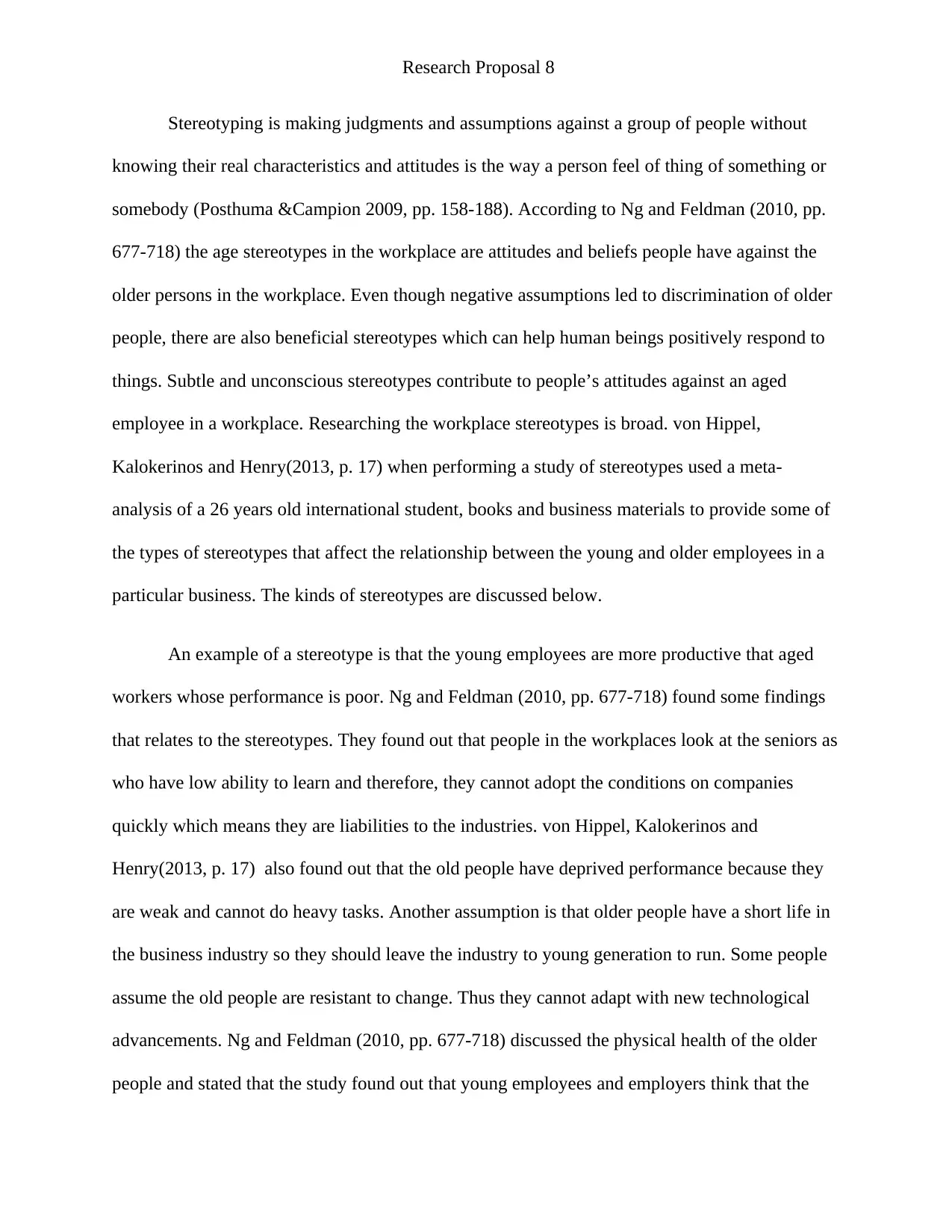
Research Proposal 8
Stereotyping is making judgments and assumptions against a group of people without
knowing their real characteristics and attitudes is the way a person feel of thing of something or
somebody (Posthuma &Campion 2009, pp. 158-188). According to Ng and Feldman (2010, pp.
677-718) the age stereotypes in the workplace are attitudes and beliefs people have against the
older persons in the workplace. Even though negative assumptions led to discrimination of older
people, there are also beneficial stereotypes which can help human beings positively respond to
things. Subtle and unconscious stereotypes contribute to people’s attitudes against an aged
employee in a workplace. Researching the workplace stereotypes is broad. von Hippel,
Kalokerinos and Henry(2013, p. 17) when performing a study of stereotypes used a meta-
analysis of a 26 years old international student, books and business materials to provide some of
the types of stereotypes that affect the relationship between the young and older employees in a
particular business. The kinds of stereotypes are discussed below.
An example of a stereotype is that the young employees are more productive that aged
workers whose performance is poor. Ng and Feldman (2010, pp. 677-718) found some findings
that relates to the stereotypes. They found out that people in the workplaces look at the seniors as
who have low ability to learn and therefore, they cannot adopt the conditions on companies
quickly which means they are liabilities to the industries. von Hippel, Kalokerinos and
Henry(2013, p. 17) also found out that the old people have deprived performance because they
are weak and cannot do heavy tasks. Another assumption is that older people have a short life in
the business industry so they should leave the industry to young generation to run. Some people
assume the old people are resistant to change. Thus they cannot adapt with new technological
advancements. Ng and Feldman (2010, pp. 677-718) discussed the physical health of the older
people and stated that the study found out that young employees and employers think that the
Stereotyping is making judgments and assumptions against a group of people without
knowing their real characteristics and attitudes is the way a person feel of thing of something or
somebody (Posthuma &Campion 2009, pp. 158-188). According to Ng and Feldman (2010, pp.
677-718) the age stereotypes in the workplace are attitudes and beliefs people have against the
older persons in the workplace. Even though negative assumptions led to discrimination of older
people, there are also beneficial stereotypes which can help human beings positively respond to
things. Subtle and unconscious stereotypes contribute to people’s attitudes against an aged
employee in a workplace. Researching the workplace stereotypes is broad. von Hippel,
Kalokerinos and Henry(2013, p. 17) when performing a study of stereotypes used a meta-
analysis of a 26 years old international student, books and business materials to provide some of
the types of stereotypes that affect the relationship between the young and older employees in a
particular business. The kinds of stereotypes are discussed below.
An example of a stereotype is that the young employees are more productive that aged
workers whose performance is poor. Ng and Feldman (2010, pp. 677-718) found some findings
that relates to the stereotypes. They found out that people in the workplaces look at the seniors as
who have low ability to learn and therefore, they cannot adopt the conditions on companies
quickly which means they are liabilities to the industries. von Hippel, Kalokerinos and
Henry(2013, p. 17) also found out that the old people have deprived performance because they
are weak and cannot do heavy tasks. Another assumption is that older people have a short life in
the business industry so they should leave the industry to young generation to run. Some people
assume the old people are resistant to change. Thus they cannot adapt with new technological
advancements. Ng and Feldman (2010, pp. 677-718) discussed the physical health of the older
people and stated that the study found out that young employees and employers think that the
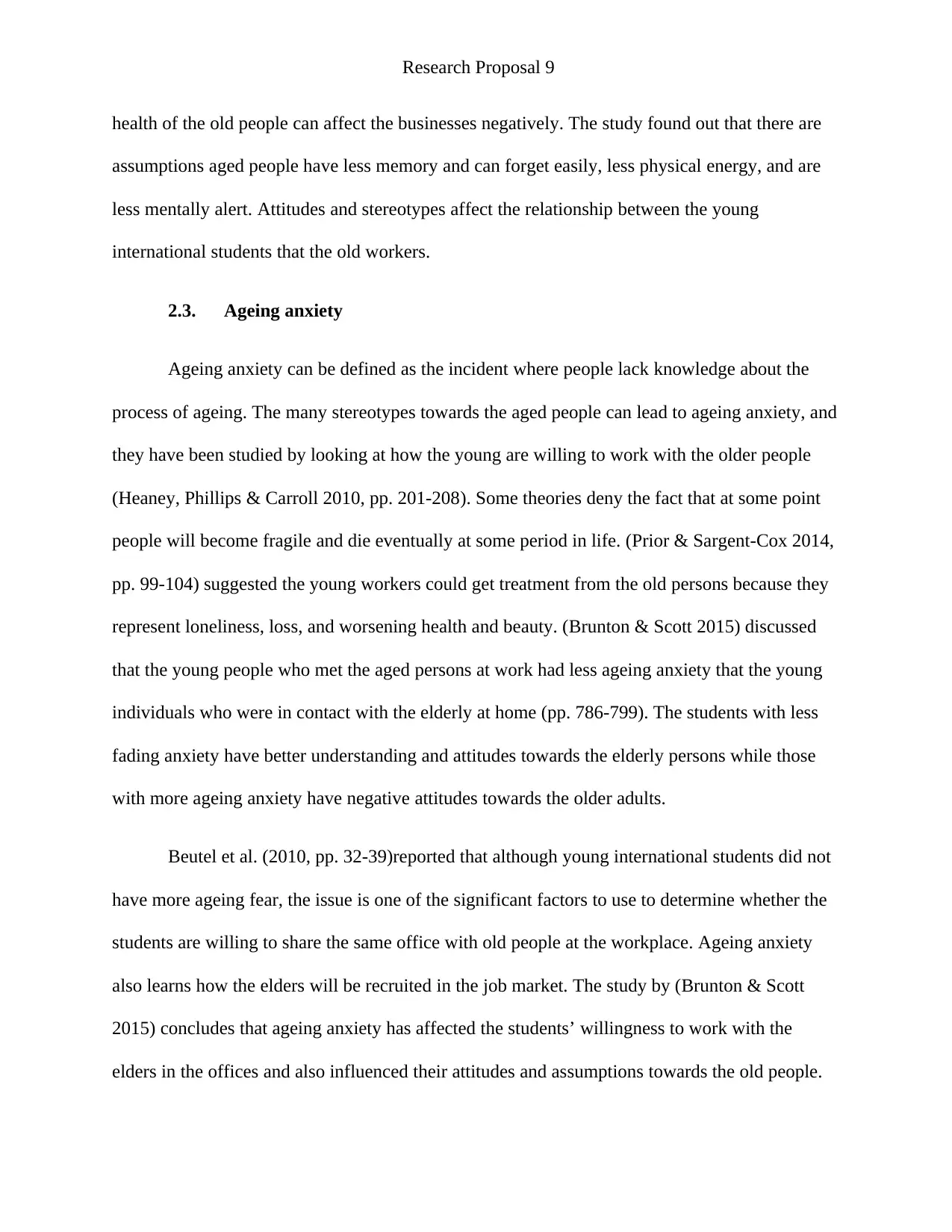
Research Proposal 9
health of the old people can affect the businesses negatively. The study found out that there are
assumptions aged people have less memory and can forget easily, less physical energy, and are
less mentally alert. Attitudes and stereotypes affect the relationship between the young
international students that the old workers.
2.3. Ageing anxiety
Ageing anxiety can be defined as the incident where people lack knowledge about the
process of ageing. The many stereotypes towards the aged people can lead to ageing anxiety, and
they have been studied by looking at how the young are willing to work with the older people
(Heaney, Phillips & Carroll 2010, pp. 201-208). Some theories deny the fact that at some point
people will become fragile and die eventually at some period in life. (Prior & Sargent-Cox 2014,
pp. 99-104) suggested the young workers could get treatment from the old persons because they
represent loneliness, loss, and worsening health and beauty. (Brunton & Scott 2015) discussed
that the young people who met the aged persons at work had less ageing anxiety that the young
individuals who were in contact with the elderly at home (pp. 786-799). The students with less
fading anxiety have better understanding and attitudes towards the elderly persons while those
with more ageing anxiety have negative attitudes towards the older adults.
Beutel et al. (2010, pp. 32-39)reported that although young international students did not
have more ageing fear, the issue is one of the significant factors to use to determine whether the
students are willing to share the same office with old people at the workplace. Ageing anxiety
also learns how the elders will be recruited in the job market. The study by (Brunton & Scott
2015) concludes that ageing anxiety has affected the students’ willingness to work with the
elders in the offices and also influenced their attitudes and assumptions towards the old people.
health of the old people can affect the businesses negatively. The study found out that there are
assumptions aged people have less memory and can forget easily, less physical energy, and are
less mentally alert. Attitudes and stereotypes affect the relationship between the young
international students that the old workers.
2.3. Ageing anxiety
Ageing anxiety can be defined as the incident where people lack knowledge about the
process of ageing. The many stereotypes towards the aged people can lead to ageing anxiety, and
they have been studied by looking at how the young are willing to work with the older people
(Heaney, Phillips & Carroll 2010, pp. 201-208). Some theories deny the fact that at some point
people will become fragile and die eventually at some period in life. (Prior & Sargent-Cox 2014,
pp. 99-104) suggested the young workers could get treatment from the old persons because they
represent loneliness, loss, and worsening health and beauty. (Brunton & Scott 2015) discussed
that the young people who met the aged persons at work had less ageing anxiety that the young
individuals who were in contact with the elderly at home (pp. 786-799). The students with less
fading anxiety have better understanding and attitudes towards the elderly persons while those
with more ageing anxiety have negative attitudes towards the older adults.
Beutel et al. (2010, pp. 32-39)reported that although young international students did not
have more ageing fear, the issue is one of the significant factors to use to determine whether the
students are willing to share the same office with old people at the workplace. Ageing anxiety
also learns how the elders will be recruited in the job market. The study by (Brunton & Scott
2015) concludes that ageing anxiety has affected the students’ willingness to work with the
elders in the offices and also influenced their attitudes and assumptions towards the old people.
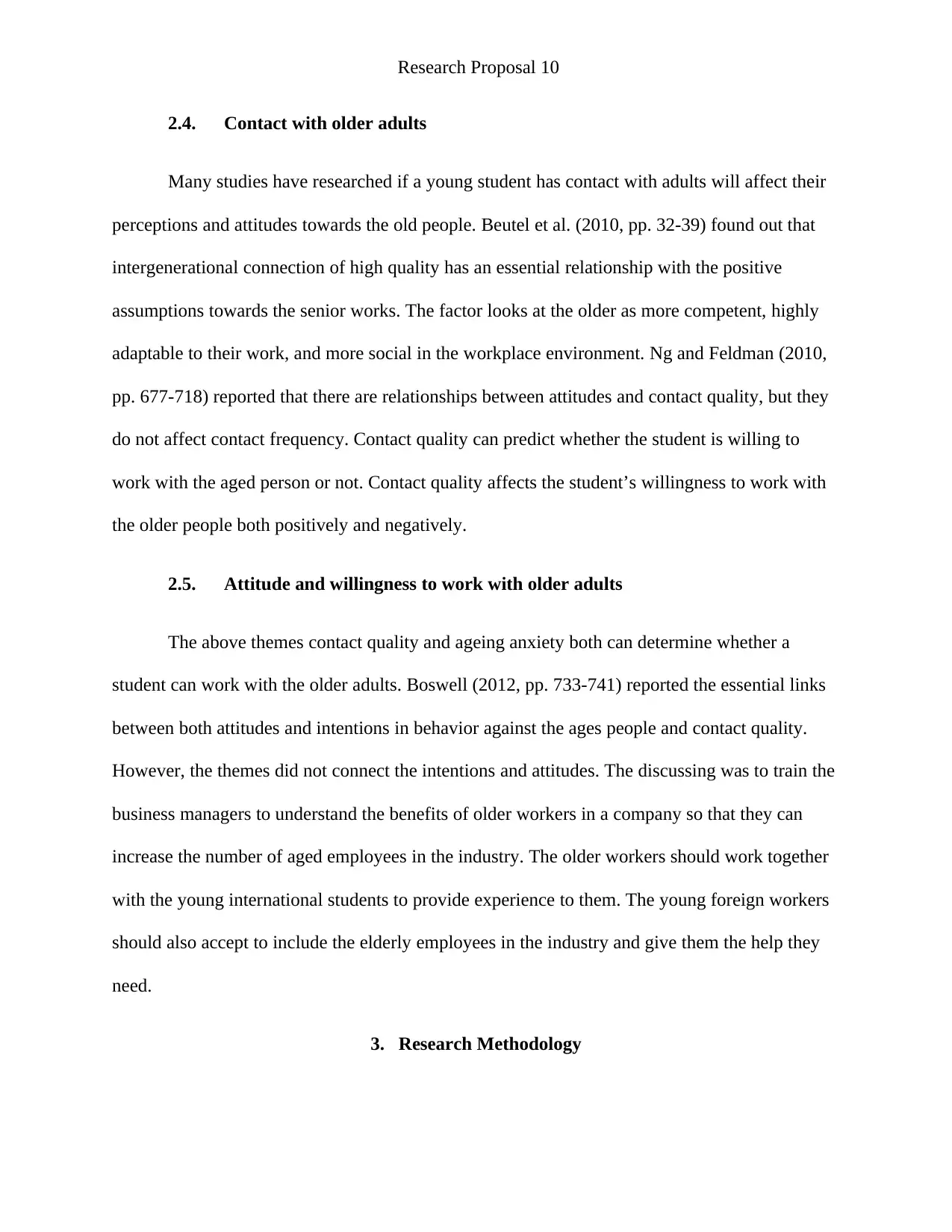
Research Proposal 10
2.4. Contact with older adults
Many studies have researched if a young student has contact with adults will affect their
perceptions and attitudes towards the old people. Beutel et al. (2010, pp. 32-39) found out that
intergenerational connection of high quality has an essential relationship with the positive
assumptions towards the senior works. The factor looks at the older as more competent, highly
adaptable to their work, and more social in the workplace environment. Ng and Feldman (2010,
pp. 677-718) reported that there are relationships between attitudes and contact quality, but they
do not affect contact frequency. Contact quality can predict whether the student is willing to
work with the aged person or not. Contact quality affects the student’s willingness to work with
the older people both positively and negatively.
2.5. Attitude and willingness to work with older adults
The above themes contact quality and ageing anxiety both can determine whether a
student can work with the older adults. Boswell (2012, pp. 733-741) reported the essential links
between both attitudes and intentions in behavior against the ages people and contact quality.
However, the themes did not connect the intentions and attitudes. The discussing was to train the
business managers to understand the benefits of older workers in a company so that they can
increase the number of aged employees in the industry. The older workers should work together
with the young international students to provide experience to them. The young foreign workers
should also accept to include the elderly employees in the industry and give them the help they
need.
3. Research Methodology
2.4. Contact with older adults
Many studies have researched if a young student has contact with adults will affect their
perceptions and attitudes towards the old people. Beutel et al. (2010, pp. 32-39) found out that
intergenerational connection of high quality has an essential relationship with the positive
assumptions towards the senior works. The factor looks at the older as more competent, highly
adaptable to their work, and more social in the workplace environment. Ng and Feldman (2010,
pp. 677-718) reported that there are relationships between attitudes and contact quality, but they
do not affect contact frequency. Contact quality can predict whether the student is willing to
work with the aged person or not. Contact quality affects the student’s willingness to work with
the older people both positively and negatively.
2.5. Attitude and willingness to work with older adults
The above themes contact quality and ageing anxiety both can determine whether a
student can work with the older adults. Boswell (2012, pp. 733-741) reported the essential links
between both attitudes and intentions in behavior against the ages people and contact quality.
However, the themes did not connect the intentions and attitudes. The discussing was to train the
business managers to understand the benefits of older workers in a company so that they can
increase the number of aged employees in the industry. The older workers should work together
with the young international students to provide experience to them. The young foreign workers
should also accept to include the elderly employees in the industry and give them the help they
need.
3. Research Methodology
Secure Best Marks with AI Grader
Need help grading? Try our AI Grader for instant feedback on your assignments.
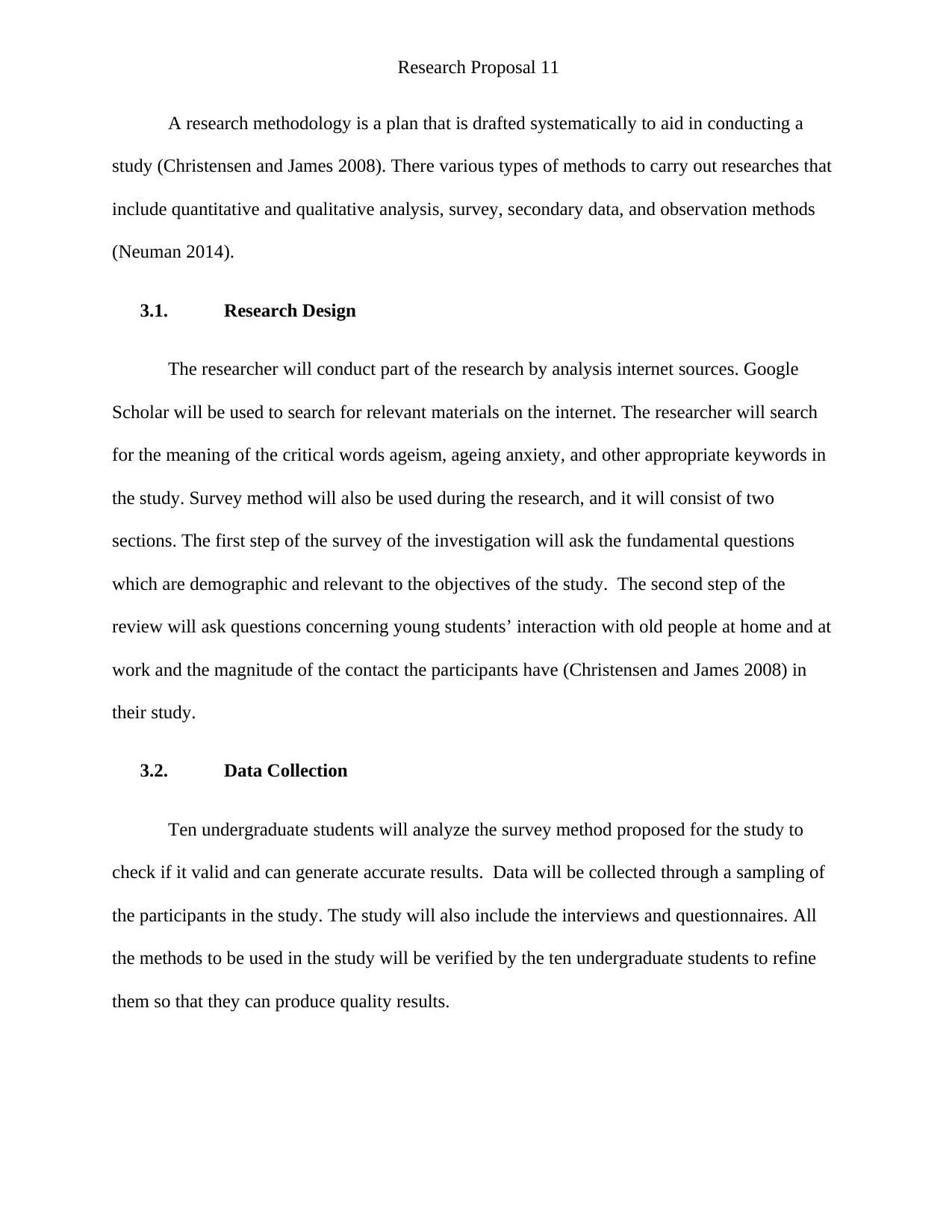
Research Proposal 11
A research methodology is a plan that is drafted systematically to aid in conducting a
study (Christensen and James 2008). There various types of methods to carry out researches that
include quantitative and qualitative analysis, survey, secondary data, and observation methods
(Neuman 2014).
3.1. Research Design
The researcher will conduct part of the research by analysis internet sources. Google
Scholar will be used to search for relevant materials on the internet. The researcher will search
for the meaning of the critical words ageism, ageing anxiety, and other appropriate keywords in
the study. Survey method will also be used during the research, and it will consist of two
sections. The first step of the survey of the investigation will ask the fundamental questions
which are demographic and relevant to the objectives of the study. The second step of the
review will ask questions concerning young students’ interaction with old people at home and at
work and the magnitude of the contact the participants have (Christensen and James 2008) in
their study.
3.2. Data Collection
Ten undergraduate students will analyze the survey method proposed for the study to
check if it valid and can generate accurate results. Data will be collected through a sampling of
the participants in the study. The study will also include the interviews and questionnaires. All
the methods to be used in the study will be verified by the ten undergraduate students to refine
them so that they can produce quality results.
A research methodology is a plan that is drafted systematically to aid in conducting a
study (Christensen and James 2008). There various types of methods to carry out researches that
include quantitative and qualitative analysis, survey, secondary data, and observation methods
(Neuman 2014).
3.1. Research Design
The researcher will conduct part of the research by analysis internet sources. Google
Scholar will be used to search for relevant materials on the internet. The researcher will search
for the meaning of the critical words ageism, ageing anxiety, and other appropriate keywords in
the study. Survey method will also be used during the research, and it will consist of two
sections. The first step of the survey of the investigation will ask the fundamental questions
which are demographic and relevant to the objectives of the study. The second step of the
review will ask questions concerning young students’ interaction with old people at home and at
work and the magnitude of the contact the participants have (Christensen and James 2008) in
their study.
3.2. Data Collection
Ten undergraduate students will analyze the survey method proposed for the study to
check if it valid and can generate accurate results. Data will be collected through a sampling of
the participants in the study. The study will also include the interviews and questionnaires. All
the methods to be used in the study will be verified by the ten undergraduate students to refine
them so that they can produce quality results.
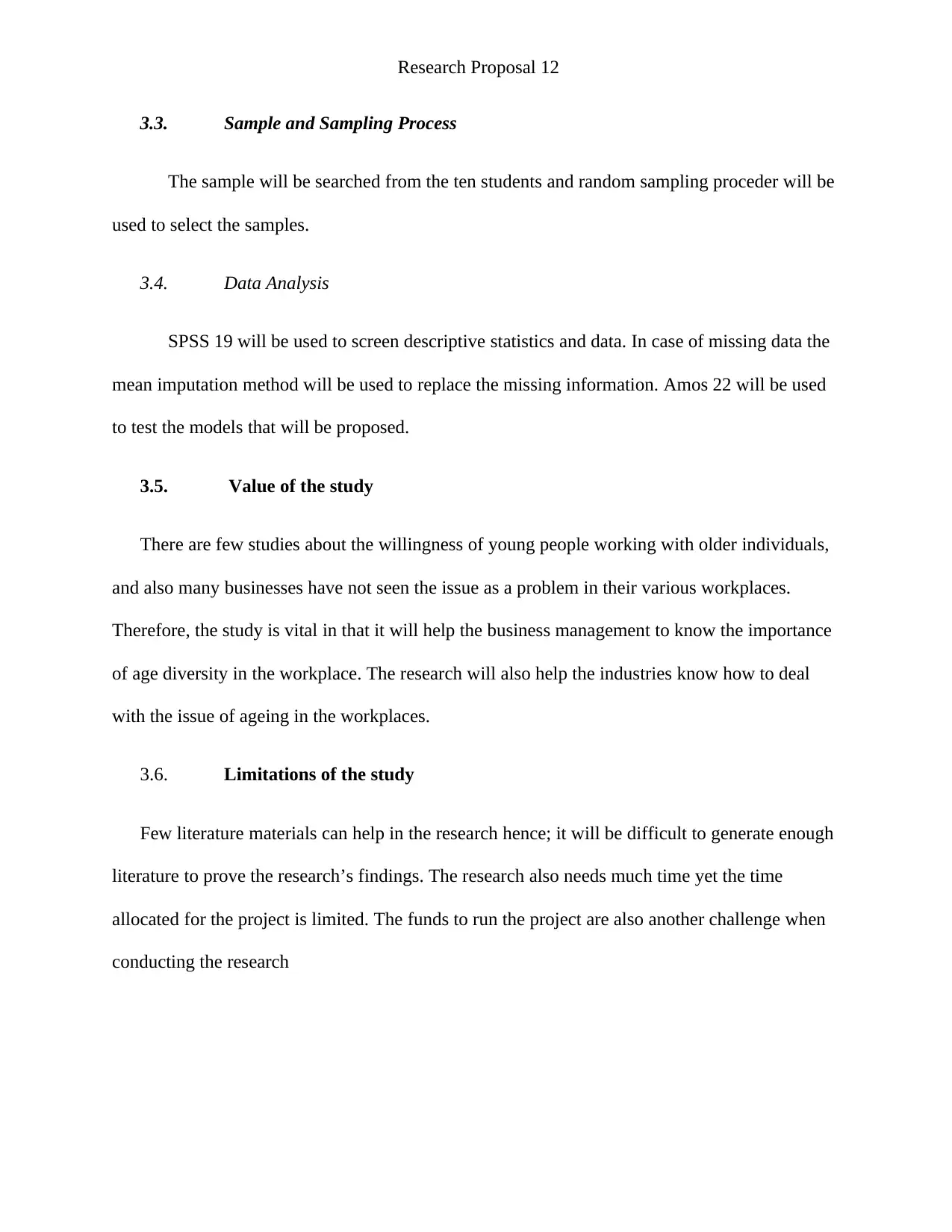
Research Proposal 12
3.3. Sample and Sampling Process
The sample will be searched from the ten students and random sampling proceder will be
used to select the samples.
3.4. Data Analysis
SPSS 19 will be used to screen descriptive statistics and data. In case of missing data the
mean imputation method will be used to replace the missing information. Amos 22 will be used
to test the models that will be proposed.
3.5. Value of the study
There are few studies about the willingness of young people working with older individuals,
and also many businesses have not seen the issue as a problem in their various workplaces.
Therefore, the study is vital in that it will help the business management to know the importance
of age diversity in the workplace. The research will also help the industries know how to deal
with the issue of ageing in the workplaces.
3.6. Limitations of the study
Few literature materials can help in the research hence; it will be difficult to generate enough
literature to prove the research’s findings. The research also needs much time yet the time
allocated for the project is limited. The funds to run the project are also another challenge when
conducting the research
3.3. Sample and Sampling Process
The sample will be searched from the ten students and random sampling proceder will be
used to select the samples.
3.4. Data Analysis
SPSS 19 will be used to screen descriptive statistics and data. In case of missing data the
mean imputation method will be used to replace the missing information. Amos 22 will be used
to test the models that will be proposed.
3.5. Value of the study
There are few studies about the willingness of young people working with older individuals,
and also many businesses have not seen the issue as a problem in their various workplaces.
Therefore, the study is vital in that it will help the business management to know the importance
of age diversity in the workplace. The research will also help the industries know how to deal
with the issue of ageing in the workplaces.
3.6. Limitations of the study
Few literature materials can help in the research hence; it will be difficult to generate enough
literature to prove the research’s findings. The research also needs much time yet the time
allocated for the project is limited. The funds to run the project are also another challenge when
conducting the research

Research Proposal 13
References List
Bell, D.N. and Blanchflower, D.G., (2011). Young people and the Great Recession. Oxford
Review of Economic Policy, 27(2), pp.241-267.
Beutel, M.E., Glaesmer, H., Wiltink, J., Marian, H. and Brähler, E., (2010). Life satisfaction,
anxiety, depression and resilience across the life span of men. The Aging Male,
13(1), pp.32-39.
Boswell, S.S., (2012). Predicting trainee ageism using knowledge, anxiety, compassion, and
contact with older adults. Educational Gerontology, 38(11), pp.733-741.
Brunton, R.J. and Scott, G., (2015). Do we fear ageing? A multidimensional approach to ageing
anxiety. Educational Gerontology, 41(11), pp.786-799.
Christensen, P. and James, A. eds., (2008). Research with children: Perspectives and practices.
Routledge.
Gullette, M.M., (2015). Aged by culture. In Routledge handbook of cultural gerontology (pp. 43-
50). Routledge.
Heaney, J.L., Phillips, A.C. and Carroll, D., (2010). Ageing, depression, anxiety, social support
and the diurnal rhythm and awakening response of salivary cortisol. International
Journal of Psychophysiology, 78(3), pp.201-208.
Hummert, M.L., (2011). Age stereotypes and aging. In Handbook of the Psychology of Aging
(Seventh Edition) (pp. 249-262).
King, S.P. and Bryant, F.B., (2017). The Workplace Intergenerational Climate Scale (WICS): A
self‐report instrument measuring ageism in the workplace. Journal of Organizational
behavior, 38(1), pp.124-151.
References List
Bell, D.N. and Blanchflower, D.G., (2011). Young people and the Great Recession. Oxford
Review of Economic Policy, 27(2), pp.241-267.
Beutel, M.E., Glaesmer, H., Wiltink, J., Marian, H. and Brähler, E., (2010). Life satisfaction,
anxiety, depression and resilience across the life span of men. The Aging Male,
13(1), pp.32-39.
Boswell, S.S., (2012). Predicting trainee ageism using knowledge, anxiety, compassion, and
contact with older adults. Educational Gerontology, 38(11), pp.733-741.
Brunton, R.J. and Scott, G., (2015). Do we fear ageing? A multidimensional approach to ageing
anxiety. Educational Gerontology, 41(11), pp.786-799.
Christensen, P. and James, A. eds., (2008). Research with children: Perspectives and practices.
Routledge.
Gullette, M.M., (2015). Aged by culture. In Routledge handbook of cultural gerontology (pp. 43-
50). Routledge.
Heaney, J.L., Phillips, A.C. and Carroll, D., (2010). Ageing, depression, anxiety, social support
and the diurnal rhythm and awakening response of salivary cortisol. International
Journal of Psychophysiology, 78(3), pp.201-208.
Hummert, M.L., (2011). Age stereotypes and aging. In Handbook of the Psychology of Aging
(Seventh Edition) (pp. 249-262).
King, S.P. and Bryant, F.B., (2017). The Workplace Intergenerational Climate Scale (WICS): A
self‐report instrument measuring ageism in the workplace. Journal of Organizational
behavior, 38(1), pp.124-151.
Paraphrase This Document
Need a fresh take? Get an instant paraphrase of this document with our AI Paraphraser

Research Proposal 14
Macdonald, J.L. and Levy, S.R., (2016). Ageism in the workplace: The role of psychosocial
factors in predicting job satisfaction, commitment, and engagement. Journal of Social
Issues, 72(1), pp.169-190.
Madge, C., Meek, J., Wellens, J. and Hooley, T., (2009). Facebook, social integration and
informal learning at university: ‘It is more for socializing and talking to friends about
work than for actually doing work’. Learning, media and technology, 34(2), pp.141-155.
Nelson, T.D., (2016). The age of ageism. Journal of social issues, 72(1), pp.191-198.
Neuman, L.W., (2014). Social research methods. Pearson Education Limited.
Ng, T.W. and Feldman, D.C., (2010). The relationships of age with job attitudes: a meta‐
analysis. Personnel Psychology, 63(3), pp.677-718.
Posthuma, R.A. and Campion, M.A., (2009). Age stereotypes in the workplace: Common
stereotypes, moderators, and future research directions. Journal of management, 35(1),
pp.158-188.
Powell, M., (2010). Ageism and abuse in the workplace: A new frontier. Journal of
gerontological social work, 53(7), pp.654-658.
Prior, K. and Sargent-Cox, K.A., (2014). Students' expectations of ageing: An evaluation of the
impact of imagined intergenerational contact and the mediating role of ageing anxiety.
Journal of Experimental Social Psychology, 55, pp.99-104.
Twenge, J.M., (2010). A review of the empirical evidence on generational differences in work
attitudes. Journal of Business and Psychology, 25(2), pp.201-210.
von Hippel, C., Kalokerinos, E.K. and Henry, J.D., (2013). Stereotype threat among older
employees: Relationship with job attitudes and turnover intentions. Psychology and
aging, 28(1), p.17.
Macdonald, J.L. and Levy, S.R., (2016). Ageism in the workplace: The role of psychosocial
factors in predicting job satisfaction, commitment, and engagement. Journal of Social
Issues, 72(1), pp.169-190.
Madge, C., Meek, J., Wellens, J. and Hooley, T., (2009). Facebook, social integration and
informal learning at university: ‘It is more for socializing and talking to friends about
work than for actually doing work’. Learning, media and technology, 34(2), pp.141-155.
Nelson, T.D., (2016). The age of ageism. Journal of social issues, 72(1), pp.191-198.
Neuman, L.W., (2014). Social research methods. Pearson Education Limited.
Ng, T.W. and Feldman, D.C., (2010). The relationships of age with job attitudes: a meta‐
analysis. Personnel Psychology, 63(3), pp.677-718.
Posthuma, R.A. and Campion, M.A., (2009). Age stereotypes in the workplace: Common
stereotypes, moderators, and future research directions. Journal of management, 35(1),
pp.158-188.
Powell, M., (2010). Ageism and abuse in the workplace: A new frontier. Journal of
gerontological social work, 53(7), pp.654-658.
Prior, K. and Sargent-Cox, K.A., (2014). Students' expectations of ageing: An evaluation of the
impact of imagined intergenerational contact and the mediating role of ageing anxiety.
Journal of Experimental Social Psychology, 55, pp.99-104.
Twenge, J.M., (2010). A review of the empirical evidence on generational differences in work
attitudes. Journal of Business and Psychology, 25(2), pp.201-210.
von Hippel, C., Kalokerinos, E.K. and Henry, J.D., (2013). Stereotype threat among older
employees: Relationship with job attitudes and turnover intentions. Psychology and
aging, 28(1), p.17.
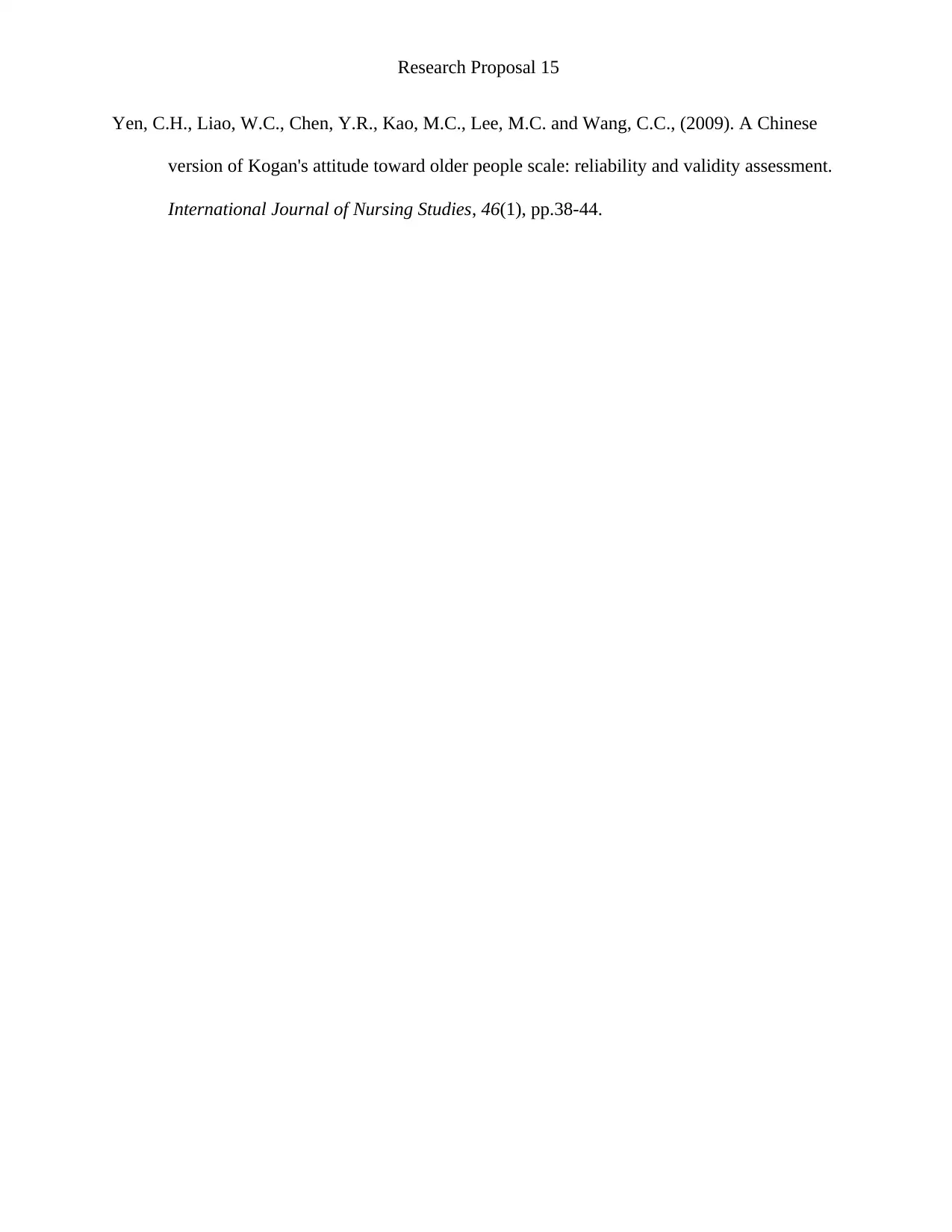
Research Proposal 15
Yen, C.H., Liao, W.C., Chen, Y.R., Kao, M.C., Lee, M.C. and Wang, C.C., (2009). A Chinese
version of Kogan's attitude toward older people scale: reliability and validity assessment.
International Journal of Nursing Studies, 46(1), pp.38-44.
Yen, C.H., Liao, W.C., Chen, Y.R., Kao, M.C., Lee, M.C. and Wang, C.C., (2009). A Chinese
version of Kogan's attitude toward older people scale: reliability and validity assessment.
International Journal of Nursing Studies, 46(1), pp.38-44.
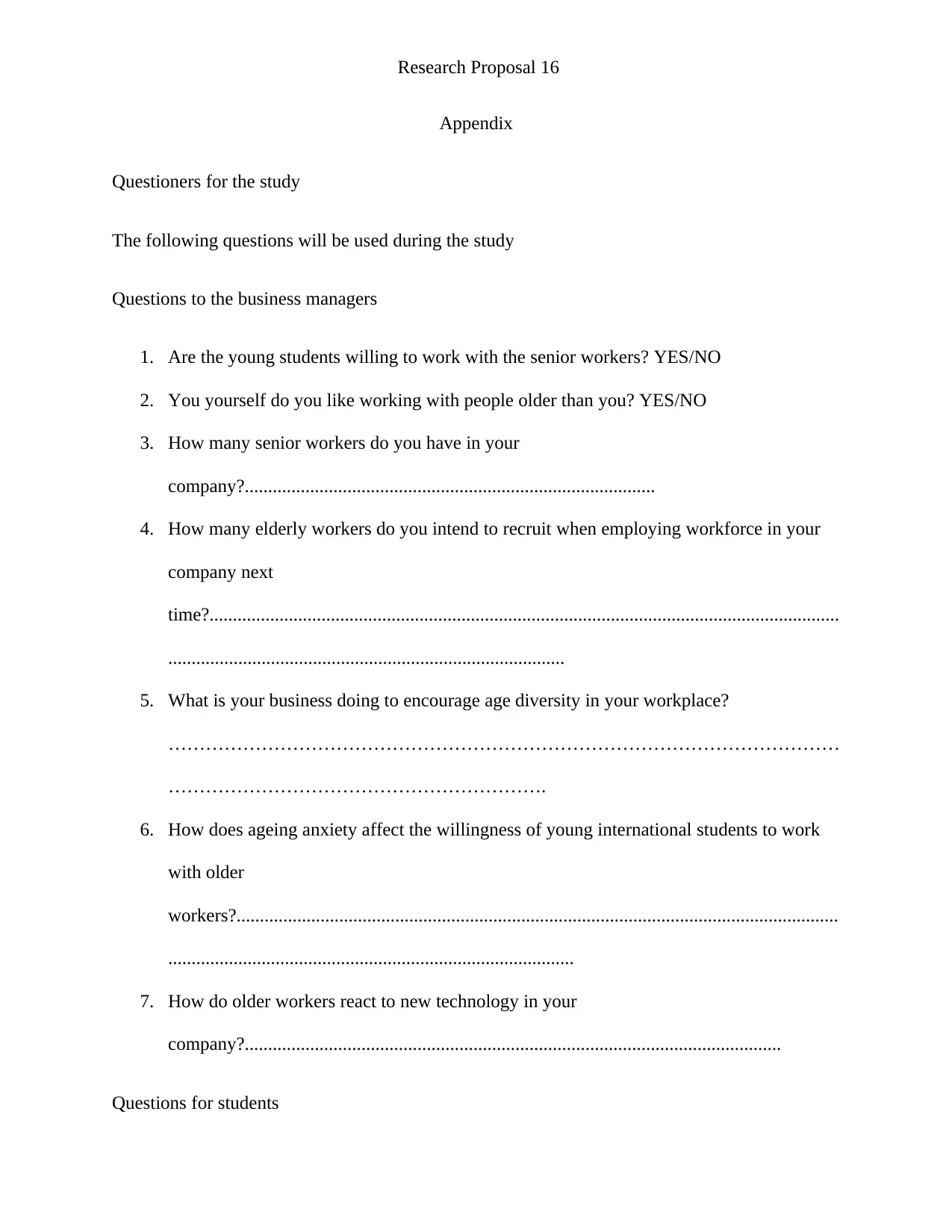
Research Proposal 16
Appendix
Questioners for the study
The following questions will be used during the study
Questions to the business managers
1. Are the young students willing to work with the senior workers? YES/NO
2. You yourself do you like working with people older than you? YES/NO
3. How many senior workers do you have in your
company?........................................................................................
4. How many elderly workers do you intend to recruit when employing workforce in your
company next
time?.......................................................................................................................................
.....................................................................................
5. What is your business doing to encourage age diversity in your workplace?
………………………………………………………………………………………………
…………………………………………………….
6. How does ageing anxiety affect the willingness of young international students to work
with older
workers?.................................................................................................................................
.......................................................................................
7. How do older workers react to new technology in your
company?...................................................................................................................
Questions for students
Appendix
Questioners for the study
The following questions will be used during the study
Questions to the business managers
1. Are the young students willing to work with the senior workers? YES/NO
2. You yourself do you like working with people older than you? YES/NO
3. How many senior workers do you have in your
company?........................................................................................
4. How many elderly workers do you intend to recruit when employing workforce in your
company next
time?.......................................................................................................................................
.....................................................................................
5. What is your business doing to encourage age diversity in your workplace?
………………………………………………………………………………………………
…………………………………………………….
6. How does ageing anxiety affect the willingness of young international students to work
with older
workers?.................................................................................................................................
.......................................................................................
7. How do older workers react to new technology in your
company?...................................................................................................................
Questions for students
Secure Best Marks with AI Grader
Need help grading? Try our AI Grader for instant feedback on your assignments.
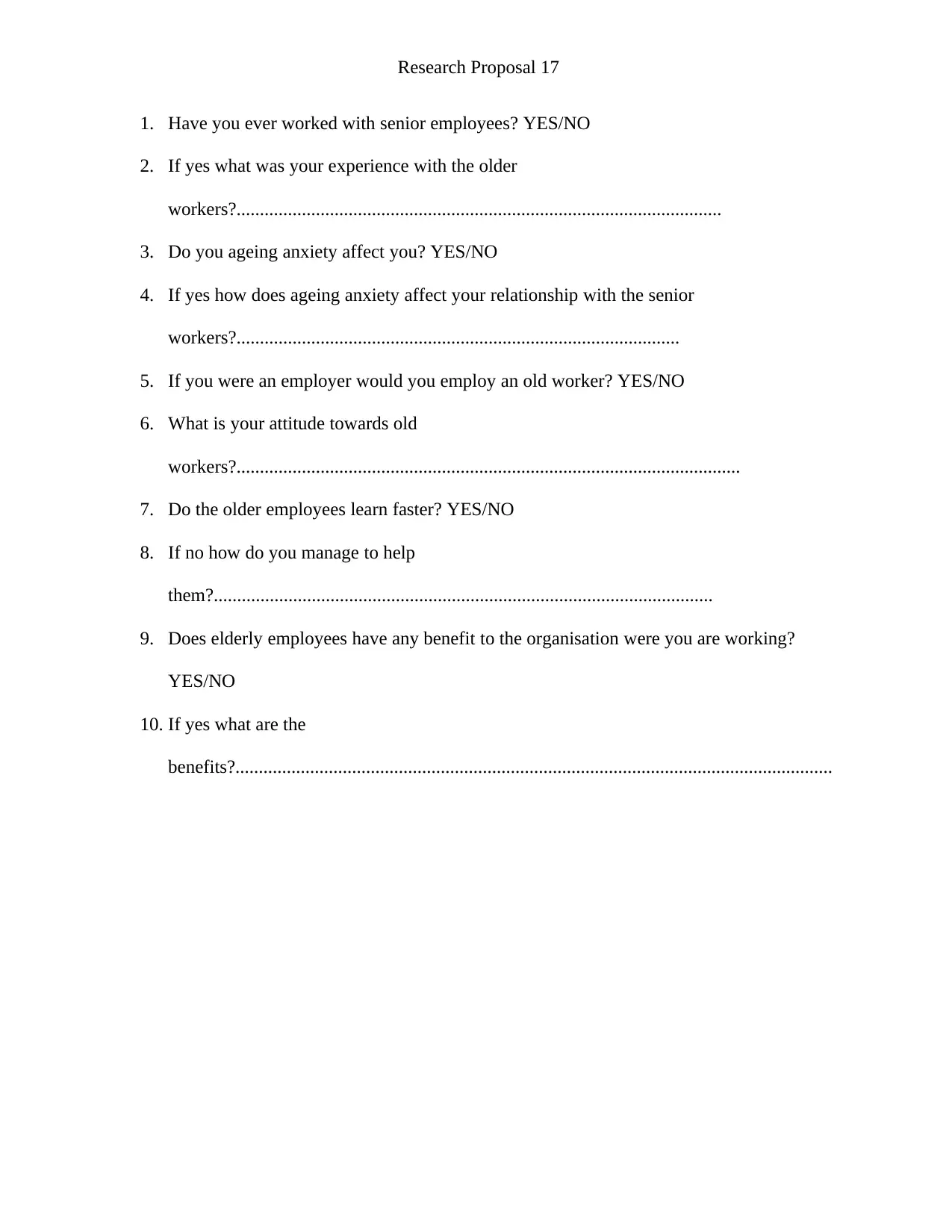
Research Proposal 17
1. Have you ever worked with senior employees? YES/NO
2. If yes what was your experience with the older
workers?........................................................................................................
3. Do you ageing anxiety affect you? YES/NO
4. If yes how does ageing anxiety affect your relationship with the senior
workers?...............................................................................................
5. If you were an employer would you employ an old worker? YES/NO
6. What is your attitude towards old
workers?............................................................................................................
7. Do the older employees learn faster? YES/NO
8. If no how do you manage to help
them?...........................................................................................................
9. Does elderly employees have any benefit to the organisation were you are working?
YES/NO
10. If yes what are the
benefits?................................................................................................................................
1. Have you ever worked with senior employees? YES/NO
2. If yes what was your experience with the older
workers?........................................................................................................
3. Do you ageing anxiety affect you? YES/NO
4. If yes how does ageing anxiety affect your relationship with the senior
workers?...............................................................................................
5. If you were an employer would you employ an old worker? YES/NO
6. What is your attitude towards old
workers?............................................................................................................
7. Do the older employees learn faster? YES/NO
8. If no how do you manage to help
them?...........................................................................................................
9. Does elderly employees have any benefit to the organisation were you are working?
YES/NO
10. If yes what are the
benefits?................................................................................................................................
1 out of 17
Related Documents
Your All-in-One AI-Powered Toolkit for Academic Success.
+13062052269
info@desklib.com
Available 24*7 on WhatsApp / Email
![[object Object]](/_next/static/media/star-bottom.7253800d.svg)
Unlock your academic potential
© 2024 | Zucol Services PVT LTD | All rights reserved.





